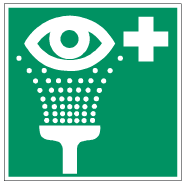Rules for emergency eye wash, shower stations

Indiscrete signage indicating the location of eye wash stations in environments where workers may come into accidental contact with corrosive materials is required by OSHA. (via Pixabay.com)
4 years, 1 month ago
 By Ellen McCulley, NCARB
By Ellen McCulley, NCARB
Nelson Design, Inc.
The following review of OSHA regulations regarding placement of emergency eye wash and shower stations first appeared in the summer 2021 editions of our wibi newsletter. Carl A. Nelson & Company is available to help clients address code-related issues in their facilities. Call (319) 754-8415, or fill out the form on the Contact page. Review past installments of Decoding the Code at www.carlanelsoncoconstruction.com/decoding-the-code/.
Who requires them?
The Occupational Safety and Health Administration (OSHA) has adopted several regulations that require the usage of emergency eye washes and showers. The primary regulation is located in 29 CFR 1910.151(c) and is as follows:
“Where the eyes or body of any person may be exposed to injurious corrosive materials, suitable facilities for quick drenching or flushing of the eyes and body shall be provided within the work area for immediate emergency use.”
ANSI/ISEA Z358.1 Emergency Eyewash and Shower Equipment is a national consensus standard that outlines the selection, installation, operation, and maintenance of emergency eyewash and shower equipment. Both the Uniform Plumbing Code and the International Plumbing Code acknowledge the hazards posed by exposure to corrosives and caustic materials and require the eyewash and shower equipment meet ANSI Z358.1.
When are they required?
Facilities are required to have eyewash/shower stations where workers are handling hazardous materials that include the following labels on the Material Safety Data Sheet: corrosive, explosive, flammable, health hazard, irritant, oxidizer, and toxic. OSHA interprets lead acid battery charging stations as not posing a personnel hazard if the caps remain on the batteries during charging.
What are the requirements?
1. The unit must be located within a walking travel distance of ten seconds from where the hazardous materials are handled. The average person walks a distance of approximately 55 feet in ten seconds.
2. The unit must also be located on the same level as the hazard and the path of travel shall be free from obstructions.
a. In prior editions of the standard, doors were not considered an obstruction. However, in the latest edition doors are considered an obstruction. The lone exception is when the hazard is not corrosive, one intervening door can be between the work area and eye wash/shower as long as it swings in the path of travel and the door cannot be locked.
b. A single step up to the enclosure where the equipment can be accessed is not considered an obstruction.
3. The station must be well lit and clearly labeled with indiscrete signage.
4. The station needs to be regularly tested and inspected.
5. The station needs the water to flow at a tepid and consistent temperature. The recommended temperature is between 60 and 100 degrees Fahrenheit.
6. Showers require a flow rate of tepid water of 20 gallons per minute.
7. If shut off valves are installed on the supply line to the unit then provisions must be made to prevent unauthorized shut off.
8. All employees must be informed of the location of the unit and instructed on proper use.
ABOUT THE AUTHOR
Ellen McCulley graduated magna cum laude with a Bachelor of Architecture from Iowa State University where she received the Pella Architectural Award from the Department of Architecture. She is a registered architect in Iowa and Illinois. Ms. McCulley joined Carl A. Nelson & Company in 2012. Learn more by calling Ellen at 319-754-8415, or write to canco@carlanelsonco.com.